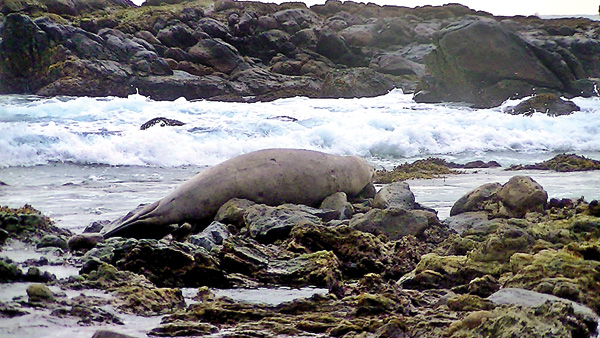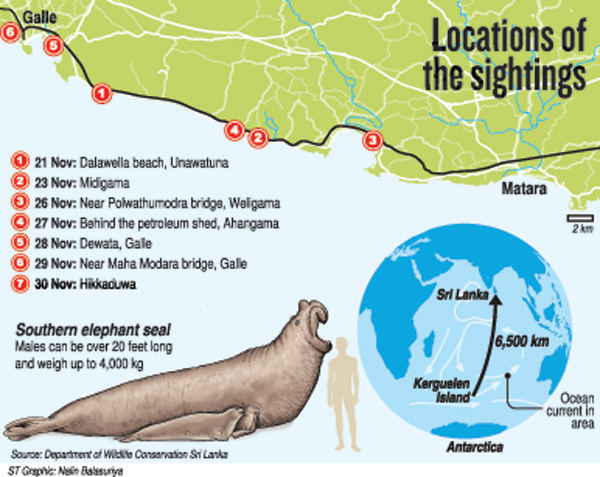News
‘Let it be free in our waters’
The southern elephant seal pup spotted at Unawatuna a fortnight ago continued to resurface off adjacent beaches: it was seen resting on rocks at Midigama on November 23, near Polwathumodara bridge in Weligama on the 26th and on successive days at Ahangama, Dewata in Galle and Mahamodara bridge in Galle. 
It is thought the animal is in distress and disoriented as the waters around Sri Lanka are much warmer than the water they naturally live in the deep Antarctic.
As the animal is resting passively on rocks it was assumed at first that it was wounded or ill. The navy and some fishermen attempted to capture the seal to check its condition but they found it to be fit and strong when it pulled a net away from them and escaped.
The Director-General of the Department of Wildlife Conservation, Chandana Sooriyabandara, said officers would not try to catch the seal again.
“Let it be free in our waters. Let the animal decide what it wants,” he said.
The problem is that local residents gather whenever the seal surfaces to gain a glimpse of the unusual visitor, some of them going very close to it to take photographs and video.
Marine mammals expert Dr. Asha de Vos asked for the seal to be given space to rest.
“Elephant seals live in Antarctic and sub-Antarctic regions so its native range would be several kilometres away from home. He is lost but might soon try to start finding its way back. It needs rest before starting its journey back,” she said.
She also warned about safety. The seal looks passive and does not move until people get very close. “But if threatened, the seal can be dangerous as it could pounce back, biting,” Dr. de Vos said.
The southern elephant seal is the largest seal species in the world with males weighing as much as four tons.
Experts believe this individual could have begun its long journey from a seal colony on Kerguelen Island in the north Antarctic, 6,400km from Sri Lanka.
Marine watcher Ranil Nanayakkara said photographs of old wounds on the seal indicated it could have been travelling for several months.
“Those rounded wounds on its back could have been caused by bites by cookie-cutter sharks,” he said. These sharks, which can grow to 22 inches, live in warm waters so this could indicate that the seal spent some time in warm waters, Mr. Nanayakkara said.
Mr. Nanayakkara warned that deeper waters around Sri Lanka would also not be safe for the seal on its return journey as there could be killer whales, which often hunt seals. 
“Perhaps the seal had been forced to change its normal route in an attempt to escape such attacks and became caught in a current that dragged it all the way to Sri Lanka,” Mr. Nanayakkara said.
A ranger at the Hikkaduwa DWC office, Uthpala Adaranga, said there was a danger of the seal becoming entangled in fishing nets as it came close to shore, and he appealed to fishermen and other locals to alert rangers if the animal was seen or found in distress.
Marine mammals veterinary surgeon Claire Simeone of the Marine Mammals Center in the United States said elephant seals eat squid and deepwater fish, and finding this prey might be a challenge for an seal this far from home.
Dr. Simeone said southern elephant seals only come onto land twice a year, to mate and for their fur to moult. While it is rare for them to come farther north than the sub-Antarctic islands where they live, there have been cases where seals have been spotted on beaches in South Africa or Brazil. There was a sighting of Southern Elephant Seal in Oman, the furthest until now in tropical waters.

